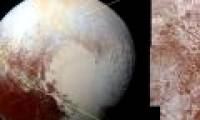

At what seemed to be the end of the solar system, the NASA New Horizons spacecraft discovered signs of a

An extremely Earth-like planet, a 385-year-long one, located in the habitat of another solar system has just been determined to be chemically qualified to form life.

NASA's New Horizons probe is flying very fast towards a mysterious object named

Pluto at the edge of the solar system is full of surprises, from erupting icebergs, faint smogs and nitro valleys.

New Horizons spacecraft from NASA has just returned to Earth with the latest image of the surface of the Pluto causing a stir in the scientific world.

NASA will begin implementing the diversion direction of New Horizons in October. It will turn to PT1 at a distance of 4 billion miles from Earth.

Seven weeks after making a historic flight through Pluto, New Horizons spacecraft from the US Aerospace Agency (NASA) began to send tens of gigabit data to Earth.

The latest image provided by New Horizons spacecraft shows evidence of Pluto's youthfulness: glaciers are flowing on its surface.

New Horizons was the first spacecraft to successfully reach Pluto after a nine-year long journey, nearly 5 billion kilometers, opening new research directions since the dwarf

 At what seemed to be the end of the solar system, the NASA New Horizons spacecraft discovered signs of a
At what seemed to be the end of the solar system, the NASA New Horizons spacecraft discovered signs of a An extremely Earth-like planet, a 385-year-long one, located in the habitat of another solar system has just been determined to be chemically qualified to form life.
An extremely Earth-like planet, a 385-year-long one, located in the habitat of another solar system has just been determined to be chemically qualified to form life. NASA's New Horizons probe is flying very fast towards a mysterious object named
NASA's New Horizons probe is flying very fast towards a mysterious object named Pluto at the edge of the solar system is full of surprises, from erupting icebergs, faint smogs and nitro valleys.
Pluto at the edge of the solar system is full of surprises, from erupting icebergs, faint smogs and nitro valleys. New Horizons spacecraft from NASA has just returned to Earth with the latest image of the surface of the Pluto causing a stir in the scientific world.
New Horizons spacecraft from NASA has just returned to Earth with the latest image of the surface of the Pluto causing a stir in the scientific world. NASA will begin implementing the diversion direction of New Horizons in October. It will turn to PT1 at a distance of 4 billion miles from Earth.
NASA will begin implementing the diversion direction of New Horizons in October. It will turn to PT1 at a distance of 4 billion miles from Earth. Seven weeks after making a historic flight through Pluto, New Horizons spacecraft from the US Aerospace Agency (NASA) began to send tens of gigabit data to Earth.
Seven weeks after making a historic flight through Pluto, New Horizons spacecraft from the US Aerospace Agency (NASA) began to send tens of gigabit data to Earth. The latest image provided by New Horizons spacecraft shows evidence of Pluto's youthfulness: glaciers are flowing on its surface.
The latest image provided by New Horizons spacecraft shows evidence of Pluto's youthfulness: glaciers are flowing on its surface. New Horizons was the first spacecraft to successfully reach Pluto after a nine-year long journey, nearly 5 billion kilometers, opening new research directions since the dwarf
New Horizons was the first spacecraft to successfully reach Pluto after a nine-year long journey, nearly 5 billion kilometers, opening new research directions since the dwarf




 NASA's 'Ninth Planet' Shows Signs of Being Friendly to Life
NASA's 'Ninth Planet' Shows Signs of Being Friendly to Life Why did American astronauts have to be quarantined when returning to Earth?
Why did American astronauts have to be quarantined when returning to Earth? China surprises the world by building a cable-stayed bridge 'above the clouds'
China surprises the world by building a cable-stayed bridge 'above the clouds' Why do women sleep less and wake up more than men?
Why do women sleep less and wake up more than men? Revealing the secret inside the stuffed animal claw machine, from there, summarizing experience to help you increase your winning rate many times over
Revealing the secret inside the stuffed animal claw machine, from there, summarizing experience to help you increase your winning rate many times over What would happen if you dug a hole through the Earth and jumped in?
What would happen if you dug a hole through the Earth and jumped in? Camera takes a photo that lasts 1,000 years
Camera takes a photo that lasts 1,000 years Was there nuclear war in ancient times?
Was there nuclear war in ancient times?